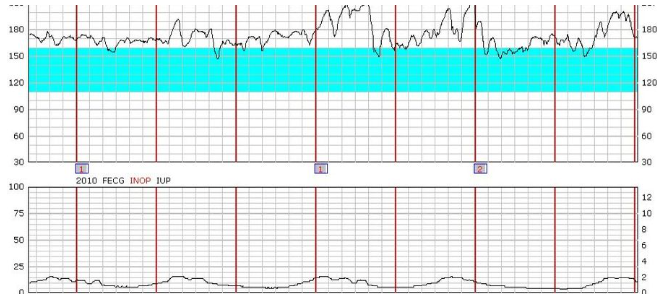FREE EFM Clinical Decision-Making Questions and Answers
Which one of the following is usually associated with fetal head compression?

Explanation:
Early decelerations are associated with fetal head compression.
Which one of the following is associated with uteroplacental insufficiency?

Explanation:
Late decelerations are associated uteroplacental insufficiency.
Which of the following patterns is typically associated with cord compression?

Explanation:
Variable decelerations are often associated with cord compression.
Describe the variability.

Explanation:
Marked variability is 25 bpm or more of fluctuation around the baseline.
Which of the following is the most important characteristic of fetal heart tracings to determine fetal well-being?
Explanation:
Variability is the single most important determinant of fetal well-being.
Which of the following is not considered a Category 3 fetal tracing?
Explanation:
Absent fetal heart rate variability is required for Category 3 tracings. Late decelerations with minimal variability is still Category 2.
Which of the following describes the criteria of an acceleration after 32 weeks gestation?
Explanation:
Accelerations in fetal heart rate after 32 weeks gestation are defined by an increase in the fetal heart rate of at least 15 beats per minute (bpm) above the baseline, lasting for at least 15 seconds. This criteria indicates fetal well-being and is considered reassuring during electronic fetal monitoring.
Advertisement
Which of the following is not a possible cause of the tachycardia seen in the last tracing?
Explanation:
Fetal heart block is not typically associated with tachycardia; instead, it often presents with bradycardia. Tachycardia in electronic fetal monitoring can be caused by maternal fever, sympathomimetic drugs, maternal hyperthyroidism, and fetal sepsis, among other factors.
Management of a prolonged deceleration should include which of the following:
Explanation:
Management of a prolonged deceleration typically involves a multifaceted approach, including maternal position change, assessment of uterine contractions, evaluation of maternal vital signs, and occasionally, a cervical examination to assess for potential causes or progress of labor.
What is the appropriate next step if a prolonged deceleration persists after maternal position change?
Explanation:
Administering oxygen to the mother can help improve oxygen delivery to the fetus and is a common intervention following a prolonged deceleration.
Which intervention is indicated if there is persistent fetal tachycardia on Electronic Fetal Monitoring?
Explanation:
Persistent fetal tachycardia can indicate fetal distress, and immediate cesarean delivery may be necessary to prevent adverse outcomes.